Recent studies have taken a shine to high-performing skylight applications, and code and certification bodies are seeing the light.
A report by The Heschong Mahone Group (HMG), an energy efficiency consultant, supports the potential for energy savings when skylights are anchored with controls that detect light levels and adjust electric lighting accordingly. The report, Effectiveness of Photocontrols with Skylighting, encourages standards committees to require photocontrols for certain daylighting applications, and some bodies are listening.
Will systems like those studied by the firm be required in your facility? Read on to find out.
Benefits of Skylighting
The consulting group focused on skylighting because of its potential and simplicity, says Lisa Heschong, principal at HMG.
“In general, skylights are the most cost-effective and easiest way to provide daylighting, and photocontrols are the next frontier for saving energy,” Heschong explains.
Using dataloggers, HMG measured actual lighting energy savings over a two-week period and compared the findings to predictions of a daylighting simulation done in SkyCalc software, which incorporated weather luminance data over the same period. It considered 32 buildings in southern California, including warehouses, retail, offices, and schools.
In daylit spaces, well-designed photocontrol systems can reduce lighting power by 50-70% for at least 2,000 hours per year, the study notes. It measured a mean realized savings ratio of 98%, with some applications performing as high as 156% against expectations due to operators shutting off lighting manually.
“Some of the owners found the automatic controls to be less aggressive than they wanted,” Heschong explains. “Skylights can provide more than enough light in given spaces.”
Systems described by users as “working well” coincided with a mean savings of 1.58 kWh per square foot, whereas systems that were categorized as “working” represented 0.90 kWh per square foot savings.
Various skylighting strategies produce different results though, and the key is finding the right type for your climate, Heschong notes.
“Think of daylight availability as a parabola shaped around solar noon, with the most at noon and the least at dawn and dusk. You want to flatten that curve out by collecting at the low angles and rejecting at the high angles, and that’s how you get really good energy performance,” she explains. “In general, the advice for the sweet spot is the highest transmission possible, the best diffusion possible, and double glazing.”
However, the benefits of skylighting reach beyond energy savings, Heschong says. Other HMG studies illustrate positive effects on worker productivity, student performance, and retail sales.
“The benefits can be described by circadian physiology. Daylight is associated with high levels of serotonin, which increases attention, motivation, and memory. It is also a precursor to the formation of melatonin at night, which helps you get regenerative sleep,” Heschong explains. “This pattern is a kind of two-pronged piston. It’s like a swing where every time you go back, you get a bigger push, and then you go higher.”
Codes and Certifications
The HMG studies have been instrumental in convincing regulators that skylighting with photocontrols produces such significant savings that they should be incorporated into code requirements, says Jon McHugh, principal of McHugh Energy Consultants Inc.
“The 2013 Title 24 in California and ASHRAE 90.1-2010 have similar requirements for buildings with 5,000 square feet of open space and ceilings of 15 feet or higher,” he explains. “For new construction of those facilities, some kind of skylight and photocontrol system is required.”
There is a proposal under review for ASHRAE to drop the criteria to 2,500 square feet.
Although not required for retrofits, McHugh hopes that utility incentives and special circumstances urge owners to make similar moves. “If you’re doing a roofing project, that’s the time to consider implementing skylighting,” he says.
As you consider skylights, beware of the many manufacturer claims, Heschong notes. “Different strategies include mirrors, shape, and optics. We are hoping for an independent testing protocol to compare them,” she adds.
Heschong plans to work with the National Fenestration Rating Council on the underdeveloped rating for skylights.
“There needs to be third-party verified data,” she says. “We’d like to use that in our simulation tools and analyze the performance of different products.”
Chris Curtland [email protected] is assistant editor of BUILDINGS.
